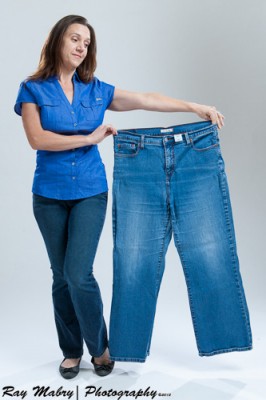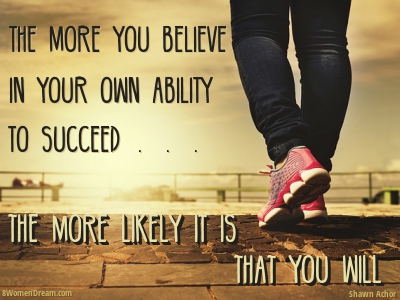Last updated on January 22nd, 2019 at 01:50 pm
 Triathlete dreamers and fitness goal enthusiasts, did you know that the most common resolutions for the new year in the U.S. are to get physically fit and eat healthier?
Triathlete dreamers and fitness goal enthusiasts, did you know that the most common resolutions for the new year in the U.S. are to get physically fit and eat healthier?
And yet, by March, most people have given up on the idea of making healthy living a permanent habit in their lives.
I distinctly remember a conversation I had with one of my sisters several years ago, before I had committed to becoming a triathlete after the age of 40. I wanted to eat healthier and drop the extra 80+ pounds that had crept on my body as I worked hard at my business while sitting at a desk for too many hours in a day.
But I thought I had to lose weight first before I could begin to even think about training to become a triathlete.
I said to her:
“I have to lose 20 pounds at the start of the new year!”
“What will happen if you don’t?” she quickly retorted.
Her question stopped me mid-thought, and I hadn’t thought about my big dream not coming true and this approach was actually setting myself up for failure.
Honestly, once I pondered her great question, I quickly realized there weren’t any real goals tied to my statement to lose twenty pounds before trying out triathlon fitness training. I wanted to lose 20 pounds to start. That was my start. The reality? I would probably starve myself to reach my weight loss goal then quickly return to my carb addiction as soon as I felt stressed without launching my real dream.
Wanting to lose 20 pounds is the perfect example of an unrealistic dream goal. It’s more wishful thinking over holding ourselves accountable for setting a realistic goal and following through with it. When we set our resolutions up this way we end up wondering why nothing radically changes in our lives from year-to-year. We wake up the following holiday season staring the same wish at the top of our New Year’s resolutions list yet again. Then we pray, hope, wish this will be the year we finally make progress and change our lives.
How many times have you set yourself up for failure this way?
Once it dawned on me that “losing 20 pounds” was more a wish than a realistic resolution, I began to think about the type of fitness I could start without thinking about the weight loss first. Meaning, how could I ease into my triathlon dream in such a way that the weight loss would become a natural byproduct of my big dream of becoming a triathlete.
How could I motivate myself to start working on my dream?
In Thomas Sterner’s excellent book, “The Practicing Mind“ he advises that when you want to accomplish something–you must start small. Break down what you want to achieve into the tiniest step, and when you take that small step, you will naturally build the momentum you need to keep going.
What small step could I take to kickstart my big dream without freaking myself out and quitting a few months from now?
It appeared to me that I could begin with purchasing a new fun pair of running shoes and one workout outfit I’d feel comfortable wearing at my current weight. I needed to start where I currently was and accept myself without judgment, which as we all know is not easy, and requires that you stay focused on the present moment.
In the past when I focused only on the wish to lose weight, my inner dialog repeatedly tortured me with thoughts of:
“You aren’t dropping weight fast enough.”
“You aren’t eating as healthy enough.”
“You ate too much today. Don’t eat lunch tomorrow.”
“Quit thinking about chocolate cake while you’re eating this awful rice cake.”
“You are such a failure for having cocktails instead of water.”
No wonder I would always quit! Who wants to listen to that kind of self-talk 24/7? I needed to look at my triathlete dream from a different perspective. I needed to start small and build momentum. I purchased my new running shoes and outfit and laid them out with my socks and sports bra right next to my bed so I would see them calling for me to put them on.
That was my first goal, and I allowed it to be my only goal until I accomplished it. The next small goal I set was to get myself to wake up 30 minutes earlier. I decided to get up with my husband who commutes quite a bit of distance for work and start my day with him. I’d get up, change into my workout clothes, put my running shoes on and join him for coffee. I didn’t set a specific workout goal or nutrition plan; I only told myself to have coffee with my husband. Then, I began to walk with him out to the car to say goodbye and go for a short walk around my neighborhood before returning home to take a shower and start my workday. On extreme weather days, I’d get on the treadmill.
My morning walks became longer over time, and before I knew it, I was trying short stints at running part of my route. Nothing big mind you, maybe half a block to start. I began to stretch afterward and look at eating a protein and vegetable breakfast–no bread. I didn’t think about lunch or dinner–I simply started my days with a healthy breakfast. Once breakfast became a habit I built on this healthy accomplishment. I stopped buying food that would tempt me to overeat or send me into a binge eating pattern. I started drinking more water. I switched to only vegetables for lunch and taking a second walk.
The walks turned to runs as I began to study how triathletes train for marathons. But again, each change I made were based on tiny goals–small shifts in my everyday habits. No vise-griping my willpower.
It took two years for me to become a triathlete and it was 10 months after buying my shoes and outfit before I felt ready to even think about entering my first marathon. In the process of setting small goals and working slowly toward my triathlete dream, I lost 100 pounds without focusing on losing 100 pounds. Can you believe that my original resolution was just to lose 20 pounds?
Wow. Was I dreaming small!
4 New Year’s Resolution Mistakes:
1. Avoid Wishful Dreaming: “I will lose 20 pounds this month.”
Instead, set a concrete goal that’s easy and simple to initiate, like my buying of my running shoes. “Joining a gym” is another obscure goal. Sure it sounds like something that will move a health and fitness dream forward, but in reality, it’s not set on anything concrete. A better goal would be to pick up an exercise you’d love to try first. Maybe try a gym that allows walk-ins and take a fitness class to see how it feels.
Your resolution might be to try one new fitness routine a week until you find one you enjoy, which could be anything from Yoga to Zumba to Belly Dancing. Once you’ve settled on something you enjoy, then work towards just one healthy meal a day five days a week and give yourself weekends off. Maybe make one meal a bowl of soup or all vegetable meal and begin there.
If you enjoy cocktails in the evening, work towards drinking a glass of water before you start and then a glass of water between cocktails, but start small. If half a glass of water is all you can manage–start there. The idea is to start with a small change that’s simple to execute, make it a habit, then set your next small goal.
2. Avoid Negative Dream Planning: “I won’t sleep in past 6:30 a.m. anymore.”
Studies have shown that people who want to replace an undesirable habit recognize there will be mental resistance that will come up and plan accordingly. If you already know that you have a hard time getting up before 6:30 a.m. plan for that with a different goal. What would get you up before 6:30 a.m.? Placing your alarm in the bathroom, so you have to leave your bedroom to turn it off?
Put an automated brewing coffee maker on your nightstand with a coffee cup and set it to make you coffee every day at 6:15 a.m., so the sound and the smell pull you up in bed?
Whatever you choose need to become habit-forming and practiced, so it becomes a permanent habit. Work to understand your weaknesses instead of beating yourself up over your failures at strengthening your resolve. Figure out a way to work with your resistance that allows you to move forward on your big dreams.

3. Avoid Single Dream Mentality: “I can do this on my own! Without help!”
Achieving something “all on my own” is a beautiful idea in theory. Personal willpower and a strong desire will take you a long way to accomplishing your resolutions, but did you know that you can significantly increase your chances for success if you connect with an accountability partner or join a group that supports you?
The American Society of Training and Development found that people are 65% more likely to meet a goal after committing to achieve it with another person. The chances of your success rate increases to 95% when you attend regular meetings to check your progress, or lack thereof. Accountability probably explains the popularity of Meetup Groups. Find a partner that will hold you accountable to your goals for the new year, or a Meetup Group, or even a life coach if you can afford one. But don’t go it alone!
4. Avoid Dream Postponing: The “I will be happy when…” Syndrome.
Happiness research expert and author of the best-selling book, “Before Happiness“, Shawn Achor, has documented in his groundwork that success doesn’t bring happiness, but happiness does create success. Achor states that focusing on the good isn’t just about overcoming your inner grump to see the glass half full. It’s about opening your mind to the ideas and opportunities that will help you be more productive, effective, and successful at work and in life.
Achor says, “When our brains continuously scan for and focus on the positive, we profit from three of the most important tools available to us:
happiness,
gratitude,
and optimism.
The role happiness plays should be obvious—the more you pick up on the positive around you, the better you’ll feel—and we’ve already seen the advantages to performance that brings. The second mechanism at work here is gratitude, because the more opportunities for positivity we see, the more grateful we become.
Psychologist Robert Emmons, who has spent nearly his entire career studying gratitude, has found that few things in life are as integral to our well-being.11 Countless other studies have shown that consistently grateful people are more energetic, emotionally intelligent, forgiving, and less likely to be depressed, anxious, or lonely.
And it’s not that people are only grateful because they are happier, either; gratitude has proven to be a significant cause of positive outcomes. When researchers pick random volunteers and train them to be more grateful over a period of a few weeks, they become happier and more optimistic, feel more socially connected, enjoy better quality sleep, and even experience fewer headaches than control groups.”

This coming year, try a different approach with your resolutions. Begin by writing your goals down on paper. New York Times bestselling author, weekly contributor to Forbes, and Founder of Leadership IQ, Mark Murphy has researched success and shares his findings. Murphy noted that vividly describing your goals in written form is strongly associated with goal success, and people who vividly describe or picture their goals in great detail are anywhere from 1.2 to 1.4 times more likely to accomplish their goals than people who don’t. Picturing a goal is probably why vision boards seem to work so well.
If you’ve been like the 92% of people who have quit your New Year’s resolutions in the first 90 days of the new year, give yourself a break by trying a new approach. Avoid the crazy this-will-happen-overnight thinking, be realistic and use my resolution suggestions to set yourself up for real success.
Start by being grateful for where you are and where you’ve been. Something prompted you to read this article today so begin anew and try these suggestions and maybe you’ll accomplish something great in the next 12 months like training to be a triathlete and running in your first marathon.
Heather Montgomery
 |  |  |  |

Heather Montgomery is a fitness writer, triathlete, and serial entrepreneur who is devoted to sharing what she has learned about becoming a triathlete after age 40. She uses her Metabolic Training Certification to help other women struggling to get fit in mid-life. She lives and trains in Santa Rosa, California, the new home of the Ironman triathlon. You can find her biking the Sonoma County wine trails.
Note: Articles by Heather may contain affiliate links and will be compensated if you make a purchase after clicking on an affiliate link.






